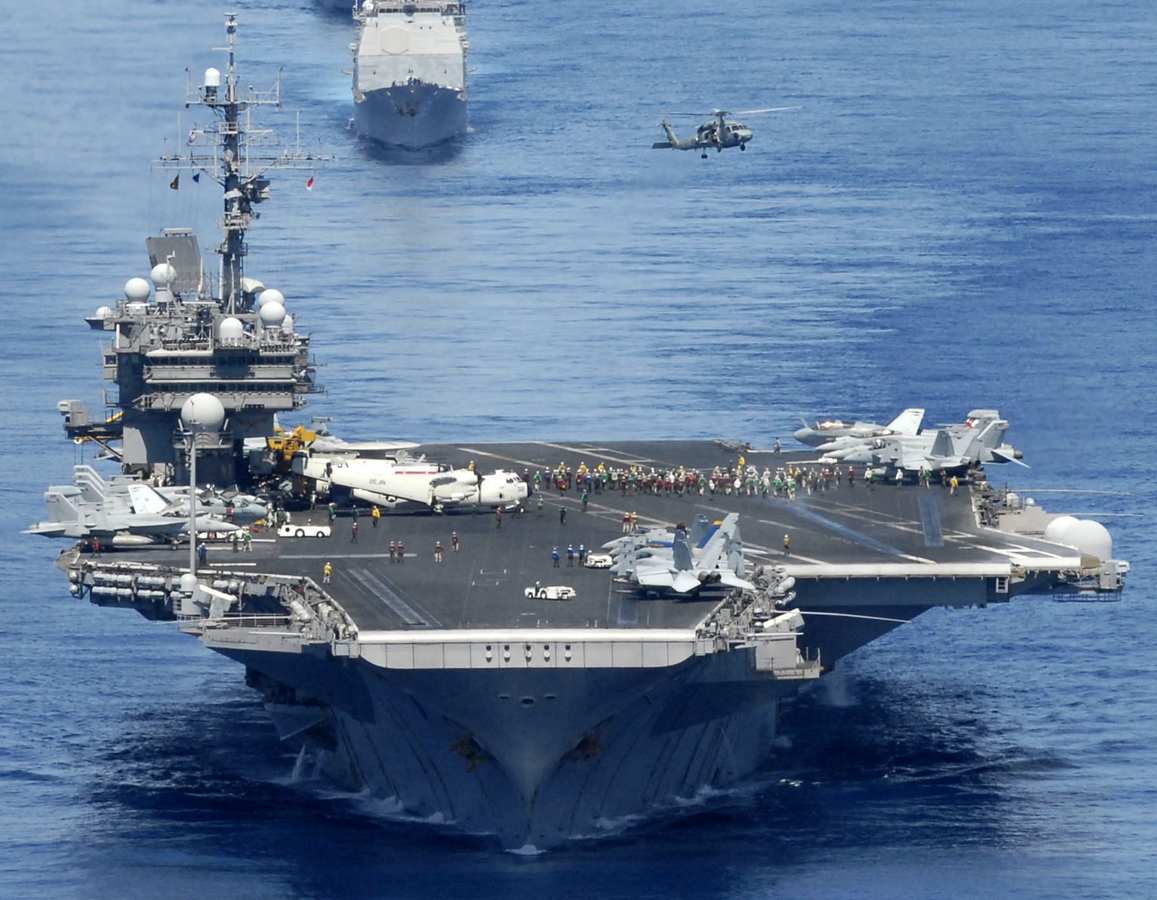The island (with the command center, the bridge, etc.) on an aircraft carrier generally seems to be located along the starboard edge. It’s a large construction, and must weight a very large amount. So how does the carrier keep from listing to the starboard side? I know the island, though tremendously heavy, is light compared to the weight of the entire ship…but it’s not inconsequential, and there must some sort of either counterweight built into the ship, or else some sort of stabilization system. Does anyone know for sure how the carrier maintains its level stability?
Ballast on (or ‘in’) the port side.
Sometimes it didn’t, or at least not completely. For example, the Independence-class light carriers of WWII typically had a slight starboard list (in part because the funnels projected pretty far out).
A related question that’s been bothering me for a while: Is there any particular reason this island is always on the starboard side?
Probably so the pilots know how they’re situated. You don’t want to come in on the nose of the flight deck.
The Japanese carriers HIRYU and AKAGI had islands on the port side. This was so when operating in formation with other carriers the traffic patterns did not conflict.
I think that the angled flight deck, wake of the carrier, landing lights, planes being catapulted off the bow and general survival instincts on behalf of all involved would take care of that bit ![]()
I googled a bit, and there seems to be a general explanation which seems reasonable. Piston powered aircraft generally have clockwise rotating propellers, which will cause the same planes to veer slightly to port due to the engine torque, so placing the island on the starboard side of the carrier gave more room for a wave-off. This seems mostly to be a convention since then.
As mentioned, IJN Hiryu and IJN Akagi were built with port-side islands in order to improve flight patters when in conjunction with starboard-side carriers (I’m thinking that the carriers would have been running line-astern with the island placements allowing approaches from separate quarters), but this was apparently not even considered a very good idea at the time.
As much as the island might weigh, it’s probably tiny compared to the weight of the rest of the carrier deck. Shift the deck a couple of feet to the left, and you’ve rebalanced the entire ship. Besides, given the asymmetric shape of the deck, it’s difficult to tell where the centerline of the hull beneath it (and therefore the center of buoyancy) is actually located.
Possibly. But it should not be especially difficult when designing the carrier to distribute things such that the ship ends up on an even keel without the need for additional ballast.
They were also originally designed as cruisers, and order converted when it didn’t look like the Essex carriers would be ready before 1944. They were redesigned in a bit of haste ![]()
What follows is a completely uneducated observation, and may be based solely on the angle of the photo linked below. That said, it seems that the deck hangs further over the port side of the ship than it does the starboard side due to the angle and necessary length of the recovery area.
Perhaps a desirable side effect is that it helps to offset the weight of the island.
Consider how many heavy things are in an aircraft carrier…
There are hundreds of different kinds of tanks within the hull holding various fluids.
For example, there are millions of gallons of JP-5 fuel for the jets.
The power plant hardware is heavy. Turbines, reduction gears, shafts, and so on. Perhaps the heaviest individual objects are the reactor vessels and their associated primary and secondary shielding.
There are lots of heavy things that can be adjusted on the ship’s prints in order to keep an even keel, even with the island on the starboard side.
And I’m certain that it all accounted for at design time.
This wiki article on the USS George HW Bush (CVN-77) states that the island weighs 700 tons, which would be less than 1% of the total weight of the ship. I’m not a naval architect (to say the least), but I doubt that’s enough to cause it to list, especially if you offset with more under deck storage on the starboard side.
I think the short answer is ballast, a computer and leave it at that because the rest looks too complicated.
There’s a 2005 paper here describing a way to fix the inherent list of all Nimitz class carriers. It only says it’s due to the ships configuration and doesn’t say exactly what causes it. Maybe the island plays a role, or maybe the island plus 100 other factors.
Apparently when the ships are fully fueled and have all the planes lined up on the starboard side, they list more than the list control system can correct for.
The system itself is only meant to keep the deck level by correcting for weight distribution when moving planes around on deck, so the ships obviously list to some degree in some direction when planes are in motion and have to correct for it constantly. I suppose the motion of the ocean is also being corrected for, but the paper specifically says the system counters all the planes and fuel and junk being moved around.
That paper may shed some light on your last question “Does anyone know for sure how the carrier maintains its level stability?”
